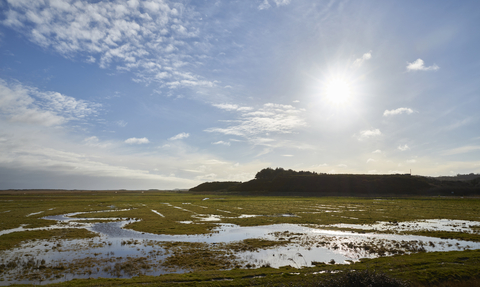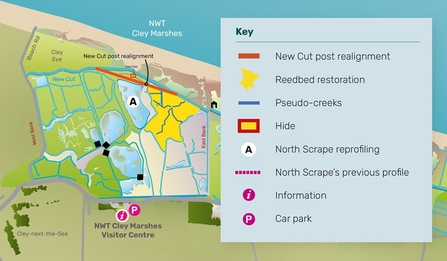
Cley Marshes (credit: Richard Osbourne)
Cley New Cut
Protecting Cley Marshes’ wildlife from rising sea levels
During September - November 2023, we undertook major works at Cley Marshes, to help the reserve and its wildlife adapt to rising sea levels and protect its freshwater habitats.
In previous winter storms, huge volumes of shingle have been pushed by waves onto the marshes, blocking parts of the ‘New Cut’ - a drain located on the north side of the reserve that removes saltwater from the site.
This work saw the most vulnerable section of the New Cut moved to the south, making it far less likely to become filled with shingle. Other works included reprofiling the North Scrape, beloved of winter waterfowl and waders, rejuvenating an area of reedbed to benefit bitterns and other reedbed species into the future.
As part of the project, we soon hope to install a new hide on wheels overlooking the North Scrape which can be towed to safety when a major storm is forecast.
This project has been funded by the Environment Agency Eastern Regional Flood and Coastal Committee and through generous donations by NWT supporters, including Cley Bird Club and the family of Robert Gillmor.

FAQ's
What is happening and why?
We are undertaking major work at Cley, to help the reserve and its wildlife adapt to rising sea levels and protect its freshwater habitats for as long as possible. In previous winter storms, huge volumes of shingle have been pushed by waves onto the reserve and the New Cut has increasingly become blocked with shingle in one vulnerable location.
The New Cut is the drain on the north side of the reserve which essentially marks the boundary between brackish and saline habitats to the north and freshwater habitats to the south. It is important for the longevity of the reserve’s freshwater habitats that the New Cut remains clear, and able to drain saltwater from the reserve during storm events, for as long as possible.
What works are included in this project?
A key part of this project will see the most vulnerable section of the New Cut moved to the south, making it far less likely to become filled with shingle.
The North Scrape, beloved of winter waterfowl and waders, will also be reprofiled. And an area of reedbed will be rejuvenated by the addition of meandering freshwater channels, accompanied by water control structures and sophisticated equipment to monitor water levels, salinity and contamination. These channels will serve as secluded hunting habitat for bitterns and other reedbed species and crucially, they will also increase the speed at which we can remove saltwater from the marsh in future storms.
We are also installing a new hide on wheels, overlooking the North Scrape, which can be towed to the safety of higher ground when a major storm is forecast.
How is the project funded?
This project has been funded by the Environment Agency Eastern Regional Flood and Coastal Committee and through generous donations by NWT supporters, including Cley Bird Club and the family of Robert Gillmor.
Will access to the reserve be different after the works have taken place?
There will be no limitations to access to the reserve following the work.
On completion of the project, we are delighted to be able to offer access to a new wildlife hide that will provide unrivalled views of the North Scrape.
For how long might the work protect Cley’s freshwater habitats from sea level rise?
It is very hard to predict the impacts of climate change, however based on modeling provided by the Environment Agency we anticipate that realigning the New Cut will put Cley in a better position to adapt to the ongoing impacts of climate change and protect the site’s freshwater habitat for decades to come.
Why are you only realigning a section of the New Cut?
The area of the New Cut that we are realigning is the only section that is currently under threat from shingle blockage. All the other sections are not under immediate threat and if we moved the whole drain further inland now, we would be reducing the area of freshwater habitat on the reserve prematurely.


Shingle beach at Cley Marshes (credit: Richard Osbourne)
Facing the future at Cley
NWT Ambassador, Nick Acheson, explores our ever-changing coastline and how we are looking to the future at our oldest nature reserve in order to protect its special wildlife as we face the growing impacts of climate change.
